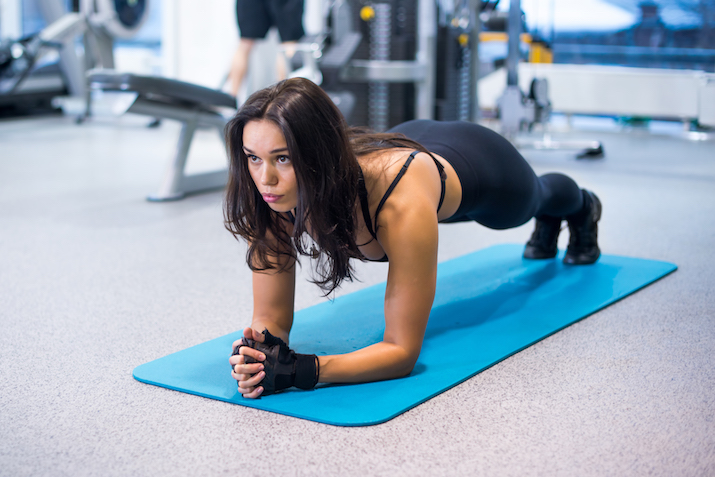
I wanted to tell you about effective core training, so I am going to discuss three of my favorite core exercises. I have many more favorites, but I’ve narrowed it down to save you the boredom!
Before attempting any of these, you need to have mastered the ability of actually bracing your core (drawing your belly button into your spine). This will activate your transverse abdominis (TVA), which is a deep muscle with the function of protecting the spine. The following exercises are designed to target the muscles surrounding your pelvis, spine, ribs and shoulders.
The 3 core exercises will work these muscles:
- Abdominals (TVA, pelvic floors, rectus abdominis, internal/external oblique’s and spinal erectors)
- Muscles surrounding the pelvis (glutes, quads, hamstrings, hip flexors)
- Muscles surrounding the upper back and shoulders (trapezius, latissimus dorsi, rhomboids, teres minor/major, pectoralis major/minor, serratus anterior, supraspinatus, infraspinatus, deltoids)
The following exercises allow for many variations, progressions and alterations which all support a strong and healthy spine and strengthen the muscles listed. This is essential for injury prevention and strength – inside the gym and during everyday activities.
The Superman
I’m going to discuss three variations: positioned on all fours, plank position, and standing. The aim is simply to extend out the opposite arm and leg, while keeping your pelvis and shoulders square to the ground. If you are new to this exercise, it is best to begin on all fours. Focus on a controlled tempo and achieving the full extension of your arm and leg. Draw back in and alternate. Once you have mastered this, you can progress to the hover, or plank, position, keepinng your elbows under your shoulders and a strong, neutral spine. From here, extend your arm and lift the opposite leg slightly–again, focusing on resisting the tilt through the pelvis and shoulders. When advancing to a standing superman, you need to be tilting forward through the hips as you extend your opposite leg and arm, aiming to get the torso near horizontal to the ground. The same principles apply, as you need to keep your pelvis and shoulders square. In this position you gain the added factor of further instability as your bodyweight is balanced on one leg.
During all three of these variations of the superman, you are moving your body through an unstable position, forcing your core muscles to engage to maintain control and stabilisation. Also, because of the extension of the leg, you will reap the benefits of glute strength. Even more so in the standing position, as the glute medius is under huge amounts of stress! This exercise also requires a lot of coordination in order to synchronize the opposite arm and leg extension, while maintaining stabilization.
Pallof Press
The Pallof Press has a massive range of variations which changes the dynamics of the exercise completely. These variations differ the exercise by changing how the muscles are contracting, manipulating where the force is coming from, or completely changing which muscles are targeted. Today, I’m just going to focus on the traditional pallof press.
This exercise can be performed either using a cable machine or a light resistance band. If using a band, you will need to anchor it at chest height and stand side on–a reasonable distance away from where the band is fixed. Set your position with your shoulders back, core braced and feet under hips. From here, simply push the band out in front of the chest and hold before slowly drawing back in.
Once you have mastered this, here’s a few alternatives to intensify the abdominal load:
- Change your stance: narrow the stance, split stance, lunge position, kneeling, kneeling split stance etc.
- Increase the resistance: heavier band or add with weight on cable machine
- Increase the length of the isometric hold
- Add a slight lift to the hold, so the handle is out above your head
The pallof press forces the abdominals to contract isometically in order to resist the body from being pulled to where the band is fixed. From holding this contracting, the core muscles are kept under load. The muscles surrounding the hip and shoulder (closest to where the band is anchored) are also heavily targeted. Also note this is a unilateral exercise, so needs to be repeated on the other side of the body too.
Planks/Hovers
I’m sure you all know what a plank/hover is. On the ground, elbows under shoulders, holding a strong and neutral spine. You do this by tensing through your quads, abdominals, and sliding your shoulder blades down if you feel your upper back rounding. In this position, you also have the option of having your knees on the ground instead of your toes, decreasing the load. Your muscles are contracting isometrically to hold yourself stable in this position.
The great thing about this exercise is the variations are ENDLESS:
- You can lift a leg or arm to resist the shift in load on your abdominals
- You can open up into a side plank, then rotate back and into the other side
- You can move into walking planks–pressing up into a plank on your hands, then back down to your forearms again
- You can step out laterally, or jump out into plank jacks
- You can even do your supermans in this position as described earlier!
These are just a few variations off the top of my head. Please let me know if you have any other variations you commonly use.
And if you have any questions on the three exercises discussed, don’t hesitate to ask.
Go give them a try if you haven’t already! We learn by DOING! 🙂



